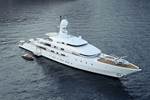Solico, Structor Engineering develop composite superyacht cinema screen
Twenty-five square-meter superyacht cinema screen supported by carbon fiber support structure which can hold the screen stable in 14 knots of wind and can be deployed in less than four minutes.
Share

Superyacht cinema screen design rendition. All photo credit: Solico Engineering, Structor Eingineering
Solico Engineering B.V. (Oosterhout, Netherlands), a composite engineering specialist for the maritime, architectural, defense and industrial sectors, announces its latest collaboration with Structor Engineering B.V. (Bantega) to provide composite engineering support for the development of a 25-square-meter outdoor cinema screen with a carbon fiber screen support structure.
The screen, commissioned for an 80-meter superyacht currently under construction, is believed to be the largest screen of its type developed to date. Its composite structure reportedly provides exceptional image quality on a screen that can be deployed by a single crew member in less than four minutes.
Over the past 20 years, Structor Engineering notes that it has built a respected position in the superyacht market, providing a range of composite mast, hinge and lock solutions to some of the most luxurious yachts afloat. In addition to the company’s telescopic carbon fiber composite mast technology, Structor believes taking on the outdoor screen project was a fitting challenge.
With client specifications calling for a screen that could be rapidly erected by just two crew members, and one that could provide a stable screen image in up to 14 knots of wind, weight reduction, stiffness and confirmation of wind loads were all key design drivers. In coordination with Structor and Solico, a 1:50 scale model of the yacht and screen was tested in the University of Eindhoven’s (Netherlands) wind tunnel, which delivered highly reliable design input data for the screen support structure.
Solico supported Structor throughout the eight-month project and provided structural verification and laminate details for the carbon fiber parts including the telescopic tubes, top member, side tubes and bottom member of the supporting structure for the cinema screen. These components were all produced by Structor’s sub-contractors, with Solico also coordinating design details between the frame components and the screen membrane itself.
In March 2021, a pre-installation test and sign-off was successfully completed, with the composite structure raised and the textile membrane tensioned to a wrinkle-free projection screen by one person in less than four minutes. According to both partners, the screen components are now going through the final finishing processes with the complete assembly planned to be installed on the superyacht in the next few months.
“We fully appreciated Solico’s breadth of knowledge and expertise for a challenging project like this. Having engineered and validated the composite structures, they were also invaluable in coordinating other technical details, reviewing the wind tunnel testing and membrane calculations” says Bouwe B. Speerstra, Structor Engineering BV.
Related Content
-
Natural fiber composites: Growing to fit sustainability needs
Led by global and industry-wide sustainability goals, commercial interest in flax and hemp fiber-reinforced composites grows into higher-performance, higher-volume applications.
-
Manufacturing the MFFD thermoplastic composite fuselage
Demonstrator’s upper, lower shells and assembly prove materials and new processes for lighter, cheaper and more sustainable high-rate future aircraft.
-
Cryo-compressed hydrogen, the best solution for storage and refueling stations?
Cryomotive’s CRYOGAS solution claims the highest storage density, lowest refueling cost and widest operating range without H2 losses while using one-fifth the carbon fiber required in compressed gas tanks.
















